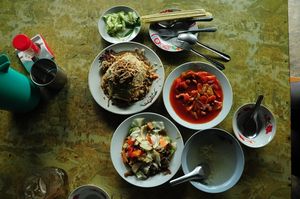Advertisement
Published: August 14th 2011

 Chinese food
Chinese food
Our default alternative to Myanmar food.Travel in Myanmar has been challenging at times but also incredibly rewarding. We’ve found it really useful to have learned a few of the basic words in Burmese and the locals have been overwhelmingly friendly and helpful. Sometimes people are quite curious and sceptical of us until we smile and say “mingalaba” (hello), and the response is almost always a big smile and a wave. In small towns such as Shwebo our faces were sore from all the smiling as nearly everyone on the street wanted to say hello.
Most cafes we eat at have no menu and we generally wait until we see someone else eating something that looks good and then point to it and ask for two of that. Café staples are generally samosas, other fried bread things, or flat-bread served with dal (lentil curry). A typical Burmese meal at a restaurant consists of a choice of a small dish of meat curry (usually just a couple of pieces of fish, chicken, lamb or pork) for a fixed price of 1000 to 1500kyat ($1-$2). This becomes an all-you-can-eat type of meal as they bring out many other plates of salads, veggie curries, soups and rice. The dishes
keep coming and if by chance you finish a plate, it’s quickly re-filled.
Arriving in Mandalay it was a bit of a shock to see so many tourists, far more than we saw even in Yangon or Bagan. This has its benefits and drawbacks, as we are no longer the centre of attention everywhere we go and there are fewer communication issues, but it also means somewhat inflated prices and more hassle from taxi drivers and touts. This is probably a good thing for the country to see so many travellers even in its low season, but we immediately felt the need to get out of the big city and back to the small towns where there isn’t so much pressure to do ‘tourism’ – perhaps a bit of burn-out? So we looked for places to go that were more off the regular tourist trail and spent 5 days hanging out in the towns of Monywa and Shwebo. In Monywa we took a day trip to a couple of religious sites and enjoyed the night market stalls. Shwebo is much less used to seeing tourists and we were followed by stares and smiles everywhere we walked. A couple of
times locals sat down with us at restaurants to chit chat and then followed up by insisting on paying for our meal. It really is one of the friendliest towns we’ve visited.
We then headed back to Mandalay where we did a quick side trip to Amarapura which is famous for the 1300yd U Bein’s Bridge – the world’s longest teak bridge. It’s interesting, but not quite as amazing as it looks in some photos we’ve seen and it attracts package tourists by the bus load.
Our trip to Myanmar would not be complete without one more adventure on the public transport system. We’re suckers for train travel, and couldn’t resist taking the 15-hour journey back to Yangon. We chose the 5:00am day train rather than the overnight train so that we could watch the scenery go by. For the most part it was a typical journey similar to our Bagan to Mandalay train until the train became stranded about 3 hours outside of Yangon as the tracks ahead were covered in 3 feet of water due to flooding of the Bago River. We were the only two foreigners on the train and were totally confused until an
older lady who spoke excellent English let us know what was going on. We latched onto her and she became our travel companion and translator the rest of the way. Eventually it was arranged that the train would turn around and head back to Mandalay; we would take it back about three hours and get off at Taungoo where we could catch an early morning bus to Yangon. We would have been so lost without our new friend since nobody else spoke any English. This is just another example of the amazing kindness we’ve experienced from so many locals we encountered. 29 hours after leaving Mandalay we arrived in Yangon.
Whether it’s the 6-hour ferry from Sittwe to Mrauk U, a tri-shaw taxi ride during a monsoon downpour, the crazy, sleepless overnight bus from Pyay to Bagan, or the unexpected 29-hour train/bus marathon from Mandalay back to Yangon it’s the travel between the major attractions that will leave us with as many memories as the sites themselves. For us, travel in Myanmar really has been about the journey rather than the destination.
Advertisement
Tot: 0.072s; Tpl: 0.013s; cc: 9; qc: 24; dbt: 0.0482s; 1; m:domysql w:travelblog (10.17.0.13); sld: 1;
; mem: 1.1mb


















cabochick
Andrea
Great Blog!
I really enjoy reading your blogs. They are informative and interesting, and your pictures are wonderful. Thanks for sharing with us!